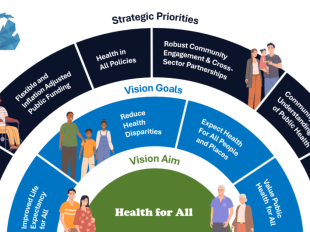Discover strategies to increase voting this election season
The link between voting and our health is clear: Residents in the places that make it easy for everyone to participate also tend to experience better health outcomes.
As the presidential election nears, research shows there are several ways to increase the number of people who register and vote. Voting is among the components that make up a community’s civic health and remains a public health priority.
Not everyone can participate in some places. But studies show that communities with higher voter turnout have fewer chronic health conditions, lower overall mortality rates, less depression and better self-reported health. States with more accessible voting policies and higher voter turnout are also linked to better quality of life and longer life expectancies. Those working in public health and health care have a role to play in encouraging civic participation.
County Health Rankings & Roadmaps offers resources that support increased civic and voter participation. Among them:
- A voter turnout measure that captures the percentage of adults who voted in the 2020 presidential election;
- County and state snapshots that reveal voter turnout in communities;
- The 2024 National Findings Report, which features research, data and examples of how people and places thrive when everyone can participate;
- What Works for Health’s curated collection of evidence-informed programs and policies, including strategies on voter turnout and voter registration;
- A recording of a webinar on the ways storytelling can inspire action and increase voter registration; and
- Our podcast, In Solidarity, which showcases interviews with experts from around the country on public health’s connection to civic health.
Civic health extends beyond voting. Volunteering, mentoring, participatory budgeting and community spaces that encourage everyone to gather and to have a say in their communities are also a part of conditions that strengthen democracy and overall health.
Barriers to voting persist despite record voting levels in the 2020 presidential election and the abundance of evidence-informed strategies that would further improve participation. In 2023, 14 states enacted laws making it harder to vote. And there are other limitations, namely the exclusion of marginalized groups in the voting process, including people of color, people with disabilities, people with lower income, people with felony convictions, young people and people with limited English proficiency.
Those in public health and health care have a role to play by understanding data about voting and health in their communities and by supporting initiatives that make it easier to register and to vote. Practitioners and organizations can also engage in movements to ensure everyone has opportunities to have a say in their communities and to live long and live well.




